
Our proud sponsors:














Sprint Samsung Galaxy TabWhat can you expect from the iPad's first real competitor?by Conrad H. Blickenstorfer
Something interesting happened in 2010. It was the year of the tablet, but there really weren't any tablets other than the iPad, which sold by the millions. But it was the year of the tablet nonetheless, with everyone discovering that tablets were, apparently, for real, just as three years ago everyone discovered that the iPhone, and what it represented, was for real. So everyone talked about their tablet plans in 2010, but only one company actually delivered an actual, live, real contender and alternative to the iPad, and that is Samsung with the Galaxy Tab you see here. Yes, Samsung delivered where others just promised, and that, too, may be a sign of things to come.
What makes the Samsung Galaxy Tab so relevant? There are several reasons.
First, it's good. Very good. A very far cry from the cheap iPad copies that became available en masse during the summer and fall of 2010. Those cheap products actually hurt the tablet form factor with their careless cheapness and complete lack of understanding what a tablet is all about. Samsung gets it, no doubt.
Second, it's the first tablet to really show off the Android OS. Without going into too much operating system detail here, the big pending question is what OS platform will prevail in becoming the main iPad/iOS alternative. Will it be Microsoft with some sort of Windows-derived tablet offering or will it be Android, the software platform that has emerged as the leading iPhone competitor? Not having a big Wintel history undoubtedly helped Samsung boldy march ahead and release its first tablet with Android.
Third, Samsung has an actual, high-volume tablet when everyone else is still just talking about it. And the Galaxy Tab is not just one of those second tier trial balloons. It's a real, honest-to-goodness product. And unlike Dell, which pussyfooted around with its litte Streak Android tablet (we never managed to pry one loose from Dell), Samsung and its partner Sprint were very proactive and accommodating in having the word on the Galaxy Tab spread. Frankly, the hunger Samsung seems to have in tackling and dominating this market feels like the hunger we once saw in the likes of NEC, Toshiba and Sony with their notebooks, before they lost their touch and Dell and HP took over with their contract-manufacturerd wares.
One somewhat regrettable aspect of the iPhone/iPad dominance is that everyone copies the Apple look, and Samsung is no different. Just like the iPhone and the iPad, the Galaxy Tab is a monolithic black slab, with the display having a black bezel, all under flush glass. On its backside, the Tab sort of splits the difference between the iPad and the iPhone, with a glossy and slightly curved backside very reminiscent of the white iPhone 3G. Even the few controls and ports are in the same places. So with tablets we may see the same thing happening as happened with phones when the iPhone came out -- I still prefer the flip-phone, but now they're all little iPhone copies. (Or not so little anymore: A recent example is the 4-inch T-Mobile Galaxy S, which essentially offers the same functionalty as a tablet, except that tablets are larger and easier to read.)
That said, the Galaxy Tab is impeccably well made. It exudes quality and solidity, very much unlike those bargain basement generic Chinese iPad copies. At first sight, the front side seems unadorned, but then you see four faint icons beneath the display. Those are the four standard Android controls: Option, Home, Escape and Search. The white icons light up when you touch them, a bit of a flaw as I need to see them before I touch them.
In the Sprint-labelled box the Galaxy came in I also found a small charger (glossy black) with USB cable desigend to accept various international power plug prong inserts; a 98-page user manual; an elegant minimalist Apple-esque "Get Started" manual; the obligatory small Sprint manual with 68 pages (!) of fine print and legalese; and an SD Card adapter for the 16GB microSD card that comes with the Galaxy Tab. No headphones, though, and no cradle or stands. Those niceties were part of the original iPhone, but have long since become aftermarket items.
So the first impression is quite good. The design is featurless and generic, but that will likely apply to all iPad competitors. Workmanship seems excellent and the device exudes quality. And the super-glossy front surface (one of the things I wouldn't copy from Apple) is entirely free of the optical distortions that are usually a dead give-away with cheap Chinese copies.
Android is based on a Linux kernel which is well suited for mobile systems due to its modest hardware requirements. There have been several attempts at making Linux popular in the handheld space, but never with much success. Versions of Linux were available, on a hacker basis, for the old Compaq iPaq. Sharp had an entire line of handhelds based on Linux, the Sharp Zaurus 5000. None of those devices ever had an impact. The problem was always the underlying complexity of the Linux operating system, and the lack of a good user interface.
With Google behind Android, the Gartner market research firm predicted a year ago that by 2012, Android would become the world's second most popular smartphone platform, behind Nokia's Symbian OS (it may be much sooner than that). And Tim Bajarin of Creative Strategies said that "Android is steadily becoming the go-to OS for smartphones and tablets."
Those familiar with the Motorola Droid or another Android phone already know how Android works. Those new to Android face a slightly steeper learning curve than iPad users. Android being a Google project means you'll need a Google account to use the major Google apps or to download apps from Google Market, or synchronize the device via Google.
Android also has a number of somewhat clumsy looking icons that show the time, signal strength, battery status and a whole slew of different notification icons in a bar on top of the screen. Android newbies will learn that you have to drag down on the status bar like a blind to see what the notifications are, and to manage them. Also, Android has both a home screen (you can have multiple home screens) with icons on it and a launcher that shows all all the rest of the app icons. If you have more programs, you can simply scroll down to view them. Below you can see the home page on my test Galaxy (left), and two pages with app icons (right):
The next set of screen snaps below shows some more Android essentials. Just like on the iPad, a Settings screen (see left) lets you access numerous configuration pages and control panels. A Task Manager (see middle) shows active applications, memory usage, installed packages and so on. All this sort of splits the difference between iOS and Windows Mobile. On the right you can see Android Market, Google's equivalent of the Apple App Store. I quickly found and downloaded some of my favorites: the Amazon Kindle reader, that silly Talking Tom cat, the ESPN ScoreCenter, ZumoDrive, VNC and, of course, the ever popular Angry Birds. Do be aware that, unlike in Apple's prim and proper App Store, it's quite easy to walk into seedier parts of Android Market (we saw some pretty vulgar stuff right off the bat).
There really was no difference in the quality and responsiveness of some of those popular apps. Playing with Google Earth, in particular, was great fun, with all the effortless zooming in, rotating and panning the iPhone/iPad are famous for. There's none of the hesitation that's almost always found in Windows-based devices, and that can make all the difference in perceived peformance.
One thing the iPad is routinely criticized for is not having a camera. Well, the Galaxy Pad has not one, but two. There's one facing the user (1.3mp; for video conferencing) and one on the rear of the device (3mp, for taking pictures). There's a very decent camera application that has as many (or more) controls and settings as your average dedicated point & shoot camera. You can do video as well, and all works well and is far more than just a technology demonstration. The Galaxy Pad has it all over the iPad here by default.
Below are three more apps I frequently used during the eval period. Browsing works extremely well. While the Galaxy Tab display is significantly smaller than the iPad screen, it has almost the same resolution (1024 x 600 versus the iPad's 1024 x 768), so everything is very sharp and crisp and you can easily read even very small text. When browsing, there is one small but noticeable difference: when you zoom in on the iPad, the text remains blurry until you let go, and then it instantly snaps into sharpness. With Android (at least on the Galaxy Pad), the system tries to stay in focus while you zoom in, but it can't really totally keep up and so the zoom seems to happen in little jumps instead of continuously, making it feel like the device struggles. Small thing, one one of the many small things Apple does so very well.
For word processing and taking notes I used the included ThinkFree Office. It worked well enough, but every Galaxy user will likely find his or her own preferred notetaker. In ThinkFree Word there did not appear to be a way to select words without having to go through a menu, and that didn't seem very intuitive.
As is, the Galaxy Tab uses a 1GHz "Hummingbird" Cortex A8 processor. It gets a bit more complex in the memory arena where the specs indicate 512MB ROM + 512MB RAM + 128MB in one D-RAM + 2GB user memory + 16GB on the pre-installed microSD (supports up to 32GB microSD card). That's a bit complex though, of course, having microSD card storage means you can pop in a bigger card, stick the card in a card reader, and so on, something you cannot do with an iPad.
For connectivity, the Galaxy Tab (I keep calling it "Pad" instead of "Tab") has 802.11b/g/n WiFi, USB via the docking cable, and BlueTooth. This being the Sprint version of the Tab, the 3G radio is of the CDMA 1900/800, EVDO Rev. A variety. For sensors, the Tab includes a very responsive accelerometer, a gyro, geomagnetic functionality, and a light sensor. The 4,000mAh battery is claimed to last up to 13 hours between charges. Battery life is good, but we did not get that much.
While the Galaxy Tab offers the same multi-touch functionality as the iPad, Samsung uses a different technology that includes Atmel's maXTouch touchscreen controller. Atmel's technology has one potentially significant advantage over Apple's projected capacitive touch implementation: you can use it with gloves on, to a degree at least. Yes, the Galaxy Tab digitizer can be operated wth certain (but not all) thin gloves on. Negating that advantage, though, is the fact that the Tab's Android buttons do not respond to gloved touch.
If you don't want a contract, Sprint offers the Galaxy Tab for US$599.99. That's not inexpensive considering that a 16GB iPad with 3G wireless costs just US$30 more, and has a much larger display. Yes, the Tab has cameras, but for once the usual Apple price premium doesn't apply here.
There's also some somewhat ominous language, like "Choose from 5 GB/mo. on our network (300 MB/mo. while off-network roaming) or 2 GB/mo. on our network (100 MB/mo. while off-network roaming). Sprint reserves the right to limit throughput speeds or amount of data transferred. Additional on network usage above plan allowance costs 5¢/MB. Off-network roaming above plan allowance costs 25¢/MB." So in this case, life with a limited data plan is a bit like Forrest Gump's box of chocolates; you never know what you gonna get. Imagine yourself downloading a movie while over the limit and off-network, and that'd be US$175, please. There are most likely alarms built in, but it just feels umcomfortable to have all those data and network restrictions when Netflix, at the same time, tells you it's moving to all-downloadable movies. So all this is sort of on collision course (and I am certainly glad that, for now, I am still grandfathered in on AT&T's unlimited data plan for my personal iPad).
The Samsung Galaxy Tab is very well made and exudes an aura of quality and durability the way Sony products used to be. The Tab is silent, runs cool, and just plain works. It's also slippery enough that you absolutely need a case for it, and the display is as glossy (reflections!) and as much of a fingerprint and smudge magnet as the iPad. I do hope that'll be fixed for all tablets sometime real soon.
Android 2.2 remains a work in progress. It works, but you can still tell that it started out on phones. Apple did a better job giving iOS on the iPad a look and feel fitting the larger display, but upcoming tablet versions of Android will most likely fix all this (as well as the lack of operational consistency and the often ugly icons).
Another plus is that you can get the Samsung Galaxy Tab on all four of the major US networks (Sprint, AT&T, Verizon, T-Mobile). The Sprint version worked very well for us, with good speed and coverage.
|
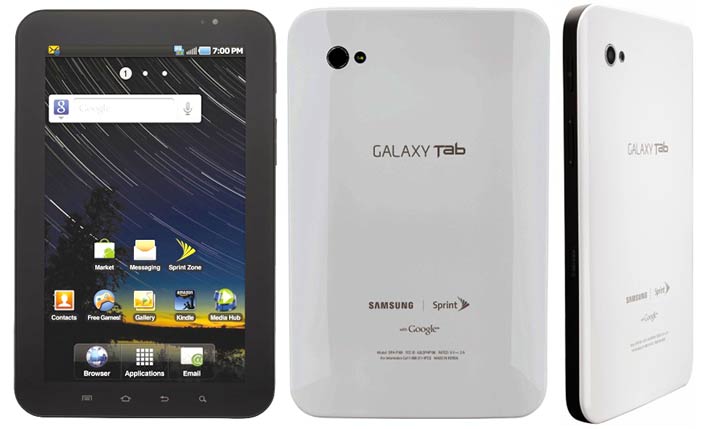
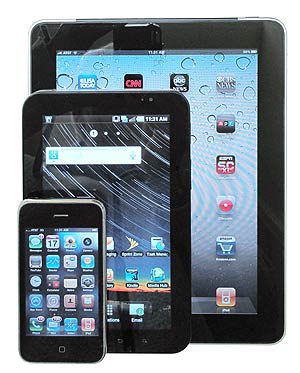 This much smaller size (4.75 x 7.5 x 0.5 inches versus the iPad's 7.5 x 9.6 x 0.5) is not necessarly bad. While Apple's Steve Jobs declared 7-inch tablets as simply too small, there is no denying that the Tab is much handier than the iPad, and it's much lighter, too (13.5 ounces versus 25 ounces). The size difference may simply turn out to be a matter of personal preference. During the time we had the Galaxy Pad, several people feltitwas just right, and those were people who had not bought an iPad because they considered it too large and heavy. The Tab feels chunkier, though. Though both are just half an inch thick, Apple used the beveling trick they used on the MacBook Air to make the device look and feel smaller, whereas the Tab is more slab-like.
This much smaller size (4.75 x 7.5 x 0.5 inches versus the iPad's 7.5 x 9.6 x 0.5) is not necessarly bad. While Apple's Steve Jobs declared 7-inch tablets as simply too small, there is no denying that the Tab is much handier than the iPad, and it's much lighter, too (13.5 ounces versus 25 ounces). The size difference may simply turn out to be a matter of personal preference. During the time we had the Galaxy Pad, several people feltitwas just right, and those were people who had not bought an iPad because they considered it too large and heavy. The Tab feels chunkier, though. Though both are just half an inch thick, Apple used the beveling trick they used on the MacBook Air to make the device look and feel smaller, whereas the Tab is more slab-like.
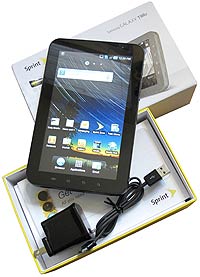 Like the iPad, the Galaxy Tab is exceptionally slippery and I wouldn't recommend anyone using it without some sort of sleeve or case. I had ordered my iPad with Apple's most excellent rubbery iPad case. The Samsung didn't come with a case (if I were Samsung, I'd ship one with the unit as many bare units will inevitably be dropped and damaged). This is the one benefit I got out of a generic Chinese tablet we had procured earlier just to see how well they worked: the rather neat leather case that came with that unit fit the Galaxy perfectly.
Like the iPad, the Galaxy Tab is exceptionally slippery and I wouldn't recommend anyone using it without some sort of sleeve or case. I had ordered my iPad with Apple's most excellent rubbery iPad case. The Samsung didn't come with a case (if I were Samsung, I'd ship one with the unit as many bare units will inevitably be dropped and damaged). This is the one benefit I got out of a generic Chinese tablet we had procured earlier just to see how well they worked: the rather neat leather case that came with that unit fit the Galaxy perfectly.
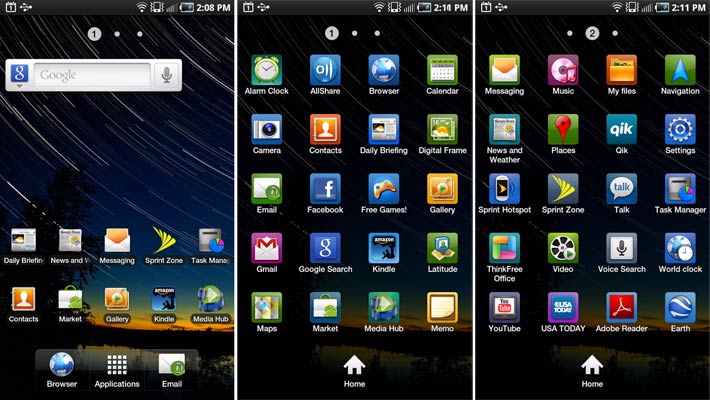
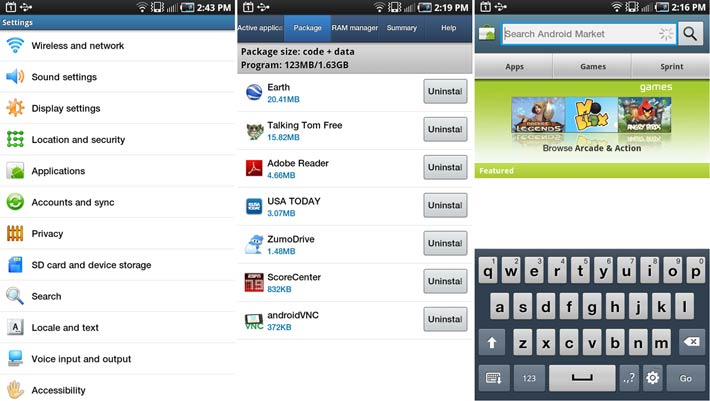
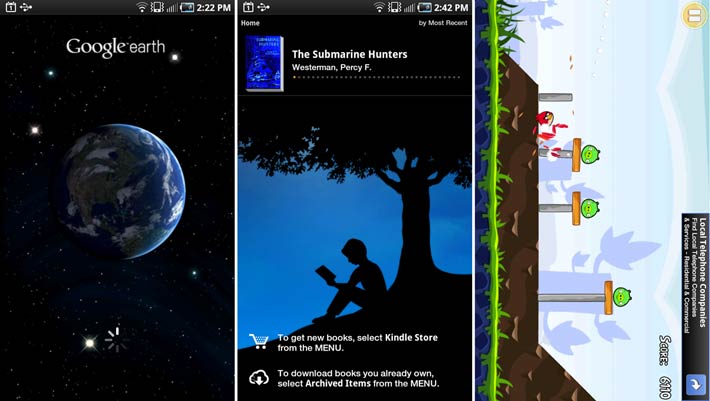
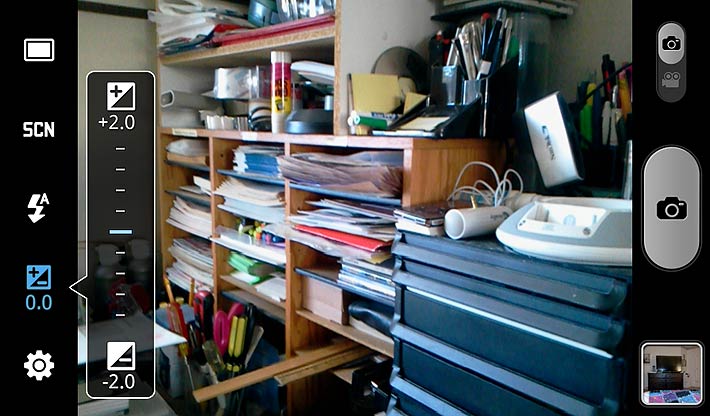

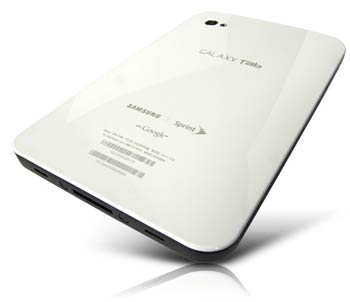 You can get the Tab for just US$399.99 if you sign up for a 2-year data plant with Sprint. As of this writing Sprint offers two plans, one that includes 2GB of data for US$29.99/month, and a 5GB plan for US$59.99/month. This sort of metered model, which all carriers now flock towards, is a potentially unsatisfying proposition for customers. Problem is, just as everything is moving away from DVDs and other physical storage media and towards downloadable streaming content (the Tab includes a competent Media Hub app where you can pay for videos and movies), the carriers start metering data. Sprint's website shows what all you can do with the two gig of data in their US$29.99 plan, and it really isn't pretty. Sure, 2GB is enough for 666,000 emails, but just 133 YouTube videos and only three feature-length movies. The carriers' argument usually is to use WiFi for downloading movies, which is silly because when you're home or in a hotel where you have WiFi, you most likely watch movies on TV.
You can get the Tab for just US$399.99 if you sign up for a 2-year data plant with Sprint. As of this writing Sprint offers two plans, one that includes 2GB of data for US$29.99/month, and a 5GB plan for US$59.99/month. This sort of metered model, which all carriers now flock towards, is a potentially unsatisfying proposition for customers. Problem is, just as everything is moving away from DVDs and other physical storage media and towards downloadable streaming content (the Tab includes a competent Media Hub app where you can pay for videos and movies), the carriers start metering data. Sprint's website shows what all you can do with the two gig of data in their US$29.99 plan, and it really isn't pretty. Sure, 2GB is enough for 666,000 emails, but just 133 YouTube videos and only three feature-length movies. The carriers' argument usually is to use WiFi for downloading movies, which is silly because when you're home or in a hotel where you have WiFi, you most likely watch movies on TV.
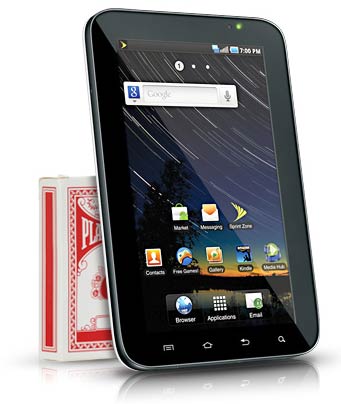 Some will want a larger display, but for many the Galaxy's superb 7-inch multi-touch screen will be just right. The Galaxy holds up amazingly well against the iPad in terms of performance, battery life, and ease of operation, all lauded strengths of the Apple tablet.
Some will want a larger display, but for many the Galaxy's superb 7-inch multi-touch screen will be just right. The Galaxy holds up amazingly well against the iPad in terms of performance, battery life, and ease of operation, all lauded strengths of the Apple tablet.